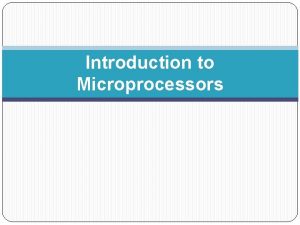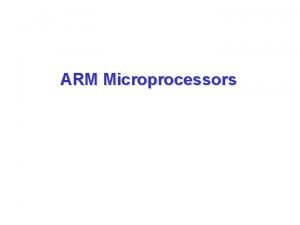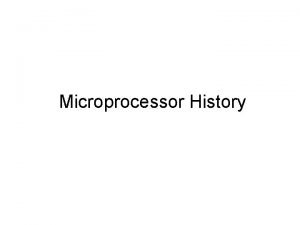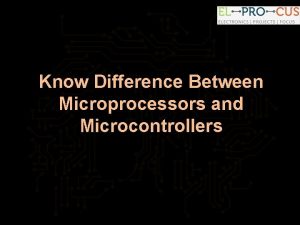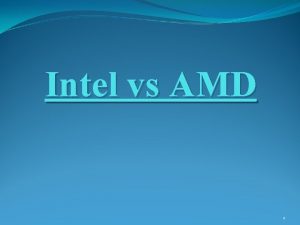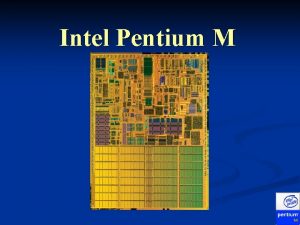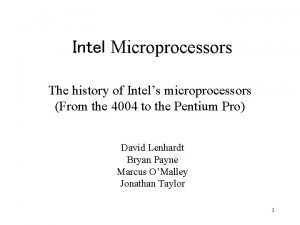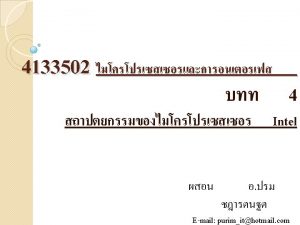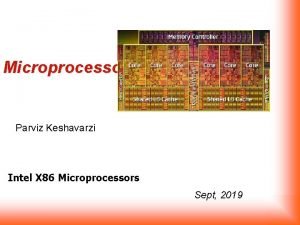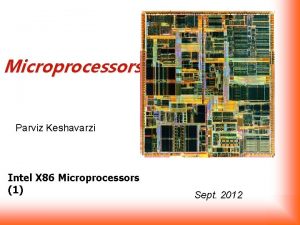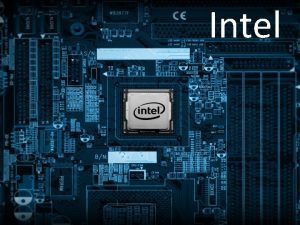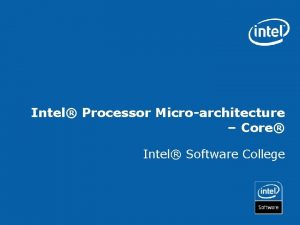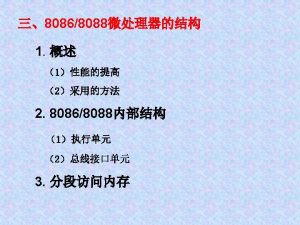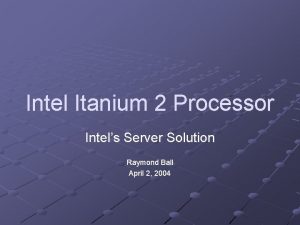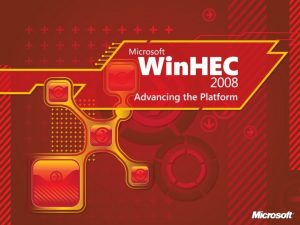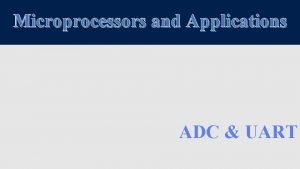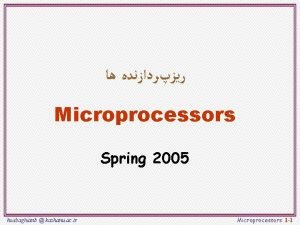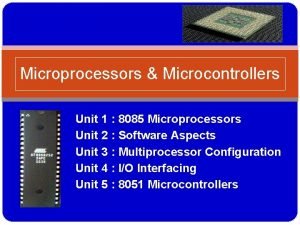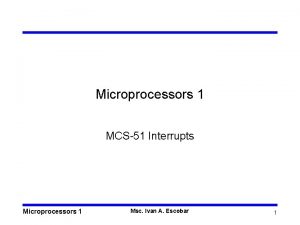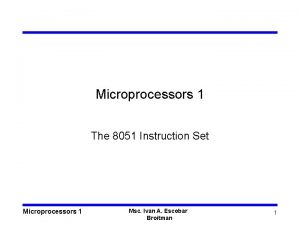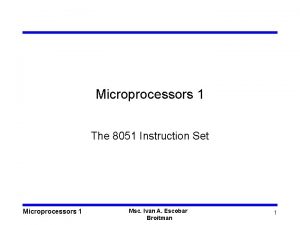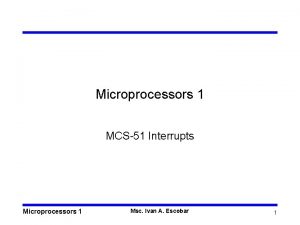Intel Microprocessors The history of Intels microprocessors From




















- Slides: 20

Intel Microprocessors The history of Intel’s microprocessors (From the 4004 to the Pentium Pro) David Lenhardt Bryan Payne Marcus O’Malley Jonathan Taylor 1

Introduction • Brief history of the microprocessor • Main features of various microprocessors • Processors mentioned: 4004, 8008, 8080, 8085, 8086, 8088, 80286, 80386, 80486, Pentium, and Pentium Pro 2

4 -bit Microprocessor • • • Busicom requested 12 calculator chips Marcian Hoff’s chip idea Federico Faggin’s 4000 chip set (4004 Specifications) 4 -bits processed at a time 12 -bit addresses 3

8 -bit Microprocessors • 8008 • Processed 8 -bits at a time • 14 -bit addresses • First to include an interrupt line • 8080 & 8085 • 16 -bit addresses • Backwards compatible 4

16 -bit and 8 -bit Microprocessors • 8086 (16 -bit) & 8088 (8 -bit) • 20 -bit addresses • Two processors which consisted of: Bus Interface Unit and Execution Unit • Segmented Memory 5

6

7

Processor Comparison Attributes 4004 8008 8080 8086 80286 Date 1971 1972 1974 1978 1982 Transistors 2, 300 3, 300 4, 500 29, 000 134, 000 Word Size 4 -bit 8 -bit 16 -bit Address Size 12 -bit 14 -bit 16 -bit 20 -bit 24 -bit Addressable Memory 4 KB 16 KB 64 KB 1 MB 16 MB Instructions 46 48 72 133+ Max Frequency 740. 74 KHz 800 KHz 2 MHz 10 MHz 12 MHz 8

80286 • Two modes – 8086 Real Address Mode – Protected Virtual Address Mode • Protected Virtual Address Mode – More address space – Multi-user protection • Dedicated 286; task – Virtual memory • Interrupt handler 9

80286 vs. 80386 Attributes 80286 80386 Date 1982 1986 Transistors 134, 000 275, 000 Word Size 16 -bit 32 -bit Address Size 24 -bit 32 -bit Addressable Memory 16 MB 4 GB Max Frequency 12 MHz 33 MHz Virtual Memory 1 GB 4 GB 10

Introduction to 80486 • • Increased speed (2 x 80386) 80386 with an internal math coprocessor Upgradeable (Compatibility) Utilize new technology (RISC, cache) 11

80486 Processor • Segmentation and Paging • Real Mode vs. Protected Mode 12

80486 Specifications Attributes 80486 Date 1981 Transistors 1, 185, 000 Word Size 16 -bit Address Size 32 -bit MIPS 26. 9 Cache 8 KB 13

Intel Pentium • • • Released in 1993 60/66 MHz Bus Speed Two Instruction Pipeline Floating Point Calculation Floating Point Bug 14

Intel Pentium Pro • • Super pipelining Integrated Level 2 Cache 32 -Bit Optimization Wider Address Bus Greater Multiprocessing Out of Order Completion Speculative Execution 15

Intel Pentium Pro, Technical Data Processor Clock Speed Bus Speed Clock Multiplier P Pro 166 MHz 2. 5 x P Pro 180 MHz 60 MHz 3 x P Pro 200 MHz 66 MHz 3 x 16

Summary • 4004 – Pentium Pro • Major Features • • • Virtual Memory Bus Pipeline Cache Reusability Segmented Memory 17

End 18

19

20
 8088 block diagram
8088 block diagram Features of a microcomputer
Features of a microcomputer Arm full form
Arm full form Pmos microprocessor
Pmos microprocessor Difference between i c $ microprocessors
Difference between i c $ microprocessors Amd vs intel history
Amd vs intel history Intel pentium history
Intel pentium history History of intel microprocessor
History of intel microprocessor Hình ảnh bộ gõ cơ thể búng tay
Hình ảnh bộ gõ cơ thể búng tay Frameset trong html5
Frameset trong html5 Bổ thể
Bổ thể Tỉ lệ cơ thể trẻ em
Tỉ lệ cơ thể trẻ em Gấu đi như thế nào
Gấu đi như thế nào Tư thế worms-breton
Tư thế worms-breton Alleluia hat len nguoi oi
Alleluia hat len nguoi oi Môn thể thao bắt đầu bằng từ chạy
Môn thể thao bắt đầu bằng từ chạy Thế nào là hệ số cao nhất
Thế nào là hệ số cao nhất Các châu lục và đại dương trên thế giới
Các châu lục và đại dương trên thế giới Công thức tính thế năng
Công thức tính thế năng Trời xanh đây là của chúng ta thể thơ
Trời xanh đây là của chúng ta thể thơ Cách giải mật thư tọa độ
Cách giải mật thư tọa độ

